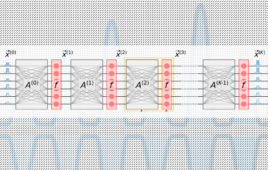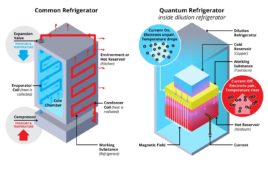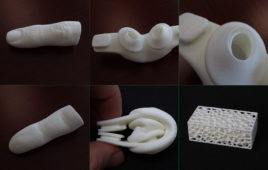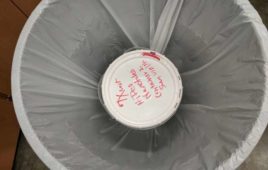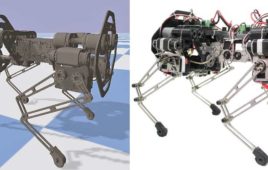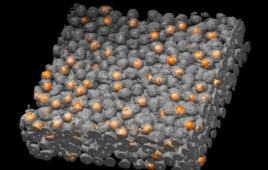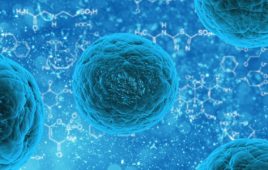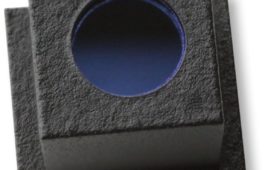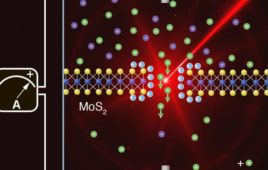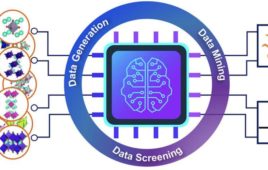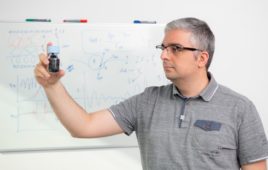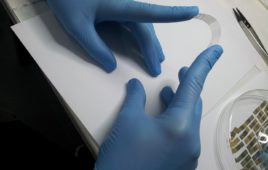When poisonous heavy metals like lead and cadmium escape from factories or mines, they can pollute the nearby soil. With no easy ways to remove these contaminants, fields must be cordoned off to prevent these toxins from entering the food chain where they threaten human and animal health. An experimental process to remove heavy metal…
Finding Fake Fingerprints
It was once the stuff of science fiction security, open your eye wide and look into the camera to gain entry to the spaceship flight deck or press a finger tip or palm of your against the pad to access the secret database that lets you take control of the baddies’ weapons. Today, of course,…
Chip Design Drastically Reduces Energy Needed to Compute with Light
MIT researchers have developed a novel “photonic” chip that uses light instead of electricity — and consumes relatively little power in the process. The chip could be used to process massive neural networks millions of times more efficiently than today’s classical computers do. Neural networks are machine-learning models that are widely used for such tasks…
Researchers Develop Superconducting Quantum Refrigerator
Imagine a refrigerator so cold it could turn atoms into their quantum states, giving them unique properties that defy the rules of classical physics. In a paper published in Physical Review Applied, Andrew Jordan, professor of physics at the University of Rochester, and his graduate student Sreenath Manikandan, along with their colleague Francesco Giazotto from the…
A 3-D Printer Powered by Machine Vision and Artificial Intelligence
Objects made with 3-D printing can be lighter, stronger, and more complex than those produced through traditional manufacturing methods. But several technical challenges must be overcome before 3-D printing transforms the production of most devices. Commercially available printers generally offer only high speed, high precision, or high-quality materials. Rarely do they offer all three, limiting…
TECHNICAL BRIEF Powerful Visual Design for Hard Cases: 3 Key Enhancements
When designing a hard sided case solution, most designers start with basic functionality – case size, protecting the parts, wheels or no wheels, and so forth. It makes sense to start here, as these functional parameters are most critical and need to be addressed adequately. However, there is an additional aspect of your packaging solution…
TECHNICAL BRIEF 6 Critical Errors to Avoid in Reusable Packaging Design
Designing a reusable, durable packaging solution for you product or service is much more than picking a type of package and a size. There are many things to consider about how your product will be used, where it will be used, and who will be using it. This list of six common errors will ensure…
Nanomaterial Safety on a Nano Budget
With a little practice, it doesn’t take much more than 10 minutes, a couple of bags and a big bucket to keep nanomaterials in their place. The Rice University lab of chemist Andrew Barron works with bulk carbon nanotubes on a variety of projects. Years ago, members of the lab became concerned that nanotubes could…
TECHNICAL BRIEF Foam Cushioning: What You Need to Know for Packaging Optimal Design
The main goal of any packaging solution is to protect the contents. When using a hard plastic case, part of the packaging equation is covered. A plastic case manufactured to industry standards, such as ATA 300 for durability or IP for water and dust protection, can be trusted to protect against the environment and repeated…
Using a Simulation Framework to Study Spine Behaviors of Quadruped Robots
Researchers at the Robert Bosch center for cyber physical systems in Bangalore, India, have recently proposed a simulation framework to systematically study the effects of spinal joint actuation on the locomotion performance of quadruped robots. In their study, outlined in a paper pre-published on arXiv, they used this framework to investigate the spine behaviors of a…
Solar Cell Defect Mystery Solved After Decades of Global Effort
Solar panels are among the most available system of generating energy through renewable sources due to their relative cost and consumer availability. Solar panels are among the most available system of generating energythrough renewable sources due to their relative cost and consumer availability. However, the majority of solar cells only achieve 20 percent efficiency—for every kW of…
Headlamp Helps Users Navigate Safely, Even on a Bicycle
With the weather warming up, outdoor activities beckon for many of us. Many of us use headlamps at night to find our way around. However, existing headlamps have limitations. A Spanish-designed headlight, called Carbi, offers several attributes that suit it for many outdoor uses. For one, the headlamp has a wider floodlight setting due to…
The Most Complete Study of Battery Failure Sees the Light
An international team of researchers just published in Advanced Energy Materials the widest study on what happens during battery failure, focusing on the different parts of a battery at the same time. The role of the ESRF, the European Synchrotron, in France, was crucial for its success. We have all experienced it: you have charged your mobile…
More Than a Love Gesture: Roses Inspire Water Purification System
Most people think of roses as something you give someone as a romantic gesture, but they may also have some energy-saving value. Researchers at the University Of Texas (UT) at Austin say a new device for collecting and purifying water was inspired by a rose and significant improves on current water recovery techniques. The flower-like…
Experts Develop Nanolasers on Silicon
Researchers at Cardiff University have shown tiny light-emitting nanolasers less than a tenth of the size of the width of a human hair can be integrated into silicon chip design. The photonic band-edge lasers can operate at superfast speeds and have the potential to help the global electronics industry deliver a range of new applications—from optical computing…
Researchers Wonder if Ancient Supernovae Prompted Human Ancestors to Walk Upright
Did ancient supernovae induce proto-humans to walk on two legs, eventually resulting in homo sapiens with hands free to build cathedrals, design rockets and snap iPhone selfies? A paper published today in the Journal of Geology makes the case: Supernovae bombarded Earth with cosmic energy starting as many as 8 million years ago, with a peak some…
Engineered Bacteria Could Be Missing Link in Energy Storage
One of the big issues with sustainable energy systems is how to store electricity that’s generated from wind, solar and waves. At present, no existing technology provides large-scale storage and energy retrieval for sustainable energy at a low financial and environmental cost. Engineered electroactive microbes could be part of the solution; these microbes are capable…
Compact Global Shutter Camera Module for Near-Infrared Mobile Facial Authentication, AR/VR Eye Tracking and Machine Vision
OmniVision Technologies, Inc., a leading developer of advanced digital imaging solutions, today announced the OVM7251 CameraCubeChip™ module. Built on the 3 micron OmniPixel®3-GS global shutter architecture, the OVM7251 offers designers a small form factor, low power consumption and cost effective 640×480 VGA resolution camera module. The module is available in an 850nm version for AR/VR…
Electrified Methane Reformer Produces Far Less Carbon Dioxide
A team of researchers from several institutions in Denmark, along with colleagues from Sintex and Haldor Topsoe, has developed an electrified methane reformer that produces far less CO2 than conventional steam-methane reformers. In their paper published in the journal Science, the group describes their new technology and how well it works. Kevin Van Geem, Vladimir Galvita and…
Producing Electricity at Estuaries Using Light and Osmosis
Most renewable power technologies are weather dependent. Wind farms can only operate when there’s a breeze, and solar power plants rely on sunlight. Researchers at EPFL are working on a method to capture an energy source that’s constantly available at river estuaries: osmotic power, also known as blue energy. Osmosis is a natural process whereby…
Robots Activated by Water May Be the Next Frontier
New research from the laboratory of Ozgur Sahin, associate professor of biological sciences and physics at Columbia University, shows that materials can be fabricated to create soft actuators–devices that convert energy into physical motion–that are strong and flexible, and, most important, resistant to water damage. “There’s a growing trend of making anything we interact with…
Data Science Helps Engineers Discover New Materials for Solar Cells and LEDS
Engineers at the University of California San Diego have developed a high-throughput computational method to design new materials for next generation solar cells and LEDs. Their approach generated 13 new material candidates for solar cells and 23 new candidates for LEDs. Calculations predicted that these materials, called hybrid halide semiconductors, would be stable and exhibit…
How to Program Materials
Ali Gooneie simulates on his computer what holds the world together right at its very core: atoms, molecules, molecular chains and bundles – then lumps and fibers, which emerge thereof. With his calculations, the Empa researcher can also explain properties we can feel with our fingertips: smooth and rough surfaces, flexible and rigid materials, heat-conductive…
Strain Enables New Applications of 2D Materials
Superconductors’ never-ending flow of electrical current could provide new options for energy storage and superefficient electrical transmission and generation, to name just a few benefits. But the signature zero electrical resistance of superconductors is reached only below a certain critical temperature, hundreds of degrees Celsius below freezing, and is very expensive to achieve. Physicists from…
How to 3-D-Print a Bathroom in One Day
Researchers from Nanyang Technological University, Singapore (NTU Singapore) have developed the capability to 3-D print an unfurnished bathroom in less than a day. After printing, the bathroom is furnished with toilet fittings to become a pre-fabricated unit, ready for use in construction projects. Its interior includes a sink, mirror, shower, toilet bowl, ceramic tiled walls and…



